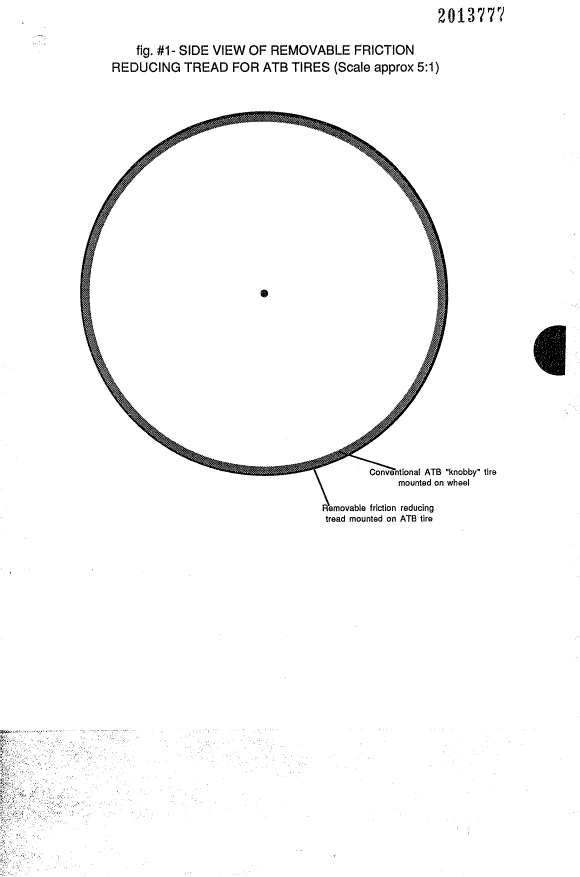Une partie des informations de ce site Web a été fournie par des sources externes. Le gouvernement du Canada n'assume aucune responsabilité concernant la précision, l'actualité ou la fiabilité des informations fournies par les sources externes. Les utilisateurs qui désirent employer cette information devraient consulter directement la source des informations. Le contenu fourni par les sources externes n'est pas assujetti aux exigences sur les langues officielles, la protection des renseignements personnels et l'accessibilité.
L'apparition de différences dans le texte et l'image des Revendications et de l'Abrégé dépend du moment auquel le document est publié. Les textes des Revendications et de l'Abrégé sont affichés :
| (12) Demande de brevet: | (11) CA 2013777 |
|---|---|
| (54) Titre français: | SEMELLE DE ROULEMENT REDUCTRICE DE FROTTEMENT ET AMOVIBLE POUR PNEUS DE BICYCLETTES DE MONTAGNE |
| (54) Titre anglais: | REMOVABLE FRICTION REDUCING TREAD FOR ALL TERRAIN BICYCLE TIRES |
| Statut: | Morte |
| (52) Classification canadienne des brevets (CCB): |
|
|---|---|
| (51) Classification internationale des brevets (CIB): |
|
| (72) Inventeurs : |
|
| (73) Titulaires : |
|
| (71) Demandeurs : | |
| (74) Agent: | |
| (74) Co-agent: | |
| (45) Délivré: | |
| (22) Date de dépôt: | 1990-04-04 |
| (41) Mise à la disponibilité du public: | 1991-10-04 |
| Licence disponible: | S.O. |
| (25) Langue des documents déposés: | Anglais |
| Traité de coopération en matière de brevets (PCT): | Non |
|---|
| (30) Données de priorité de la demande: | S.O. |
|---|
ABSTRACT OF PATENT
REMOVABLE FRICTION REDUCING TREAD
FOR ALL TERRAIN BICYCLE TIRES
The tires of an all terrain bicycle (ATB) are converted from being
wide, soft and covered with knobs as required for traction in dirt
tires which are narrow, hard and smooth so as to greatly reduce the
ATBs rolling friction over pavement. Installing this invention when
appropriate allows the ATB to efficiently serve both for recreational
purposes and commuting purposes. The invention takes the form of
a removable hoop who's inside diameter is slightly smaller than the
outside diameter of a standard ATB tire. It is attached to the ATB
tire utilizing friction resulting from de-flating the ATB tire, forcing
the tread hoop onto its center and then re-inflating the tire. The
hoop itself is composed of two elements. The first is an inner band
made of steel, carbon fiber or other material having high rigidity and
tensile strength. This band provides tensile strength in the hoop,
distributes the load from the hoop onto multiple knobs on the ATB
tire and also keeps the hoop circular despite the widely spaced knobs
supporting it. The second component of the rubber hoop is the
rubber itself which forms the low friction tread and inside of which
the tensile band is encased. The rubber component is roughly semi-
circular in cross section and has the tensile band cast within it near
its slightly concave inner side. The convex outer surface of the
rubber component has a shallow road racing tread pattern cast into
it.
Note : Les revendications sont présentées dans la langue officielle dans laquelle elles ont été soumises.
Note : Les descriptions sont présentées dans la langue officielle dans laquelle elles ont été soumises.

Pour une meilleure compréhension de l'état de la demande ou brevet qui figure sur cette page, la rubrique Mise en garde , et les descriptions de Brevet , États administratifs , Taxes périodiques et Historique des paiements devraient être consultées.
| Titre | Date |
|---|---|
| Date de délivrance prévu | Non disponible |
| (22) Dépôt | 1990-04-04 |
| (41) Mise à la disponibilité du public | 1991-10-04 |
| Demande morte | 1992-10-05 |
Il n'y a pas d'historique d'abandonnement
| Type de taxes | Anniversaire | Échéance | Montant payé | Date payée |
|---|---|---|---|---|
| Le dépôt d'une demande de brevet | 0,00 $ | 1990-04-04 |
Les titulaires actuels et antérieures au dossier sont affichés en ordre alphabétique.
| Titulaires actuels au dossier |
|---|
| KIELLAND, PETER J. |
| Titulaires antérieures au dossier |
|---|
| S.O. |